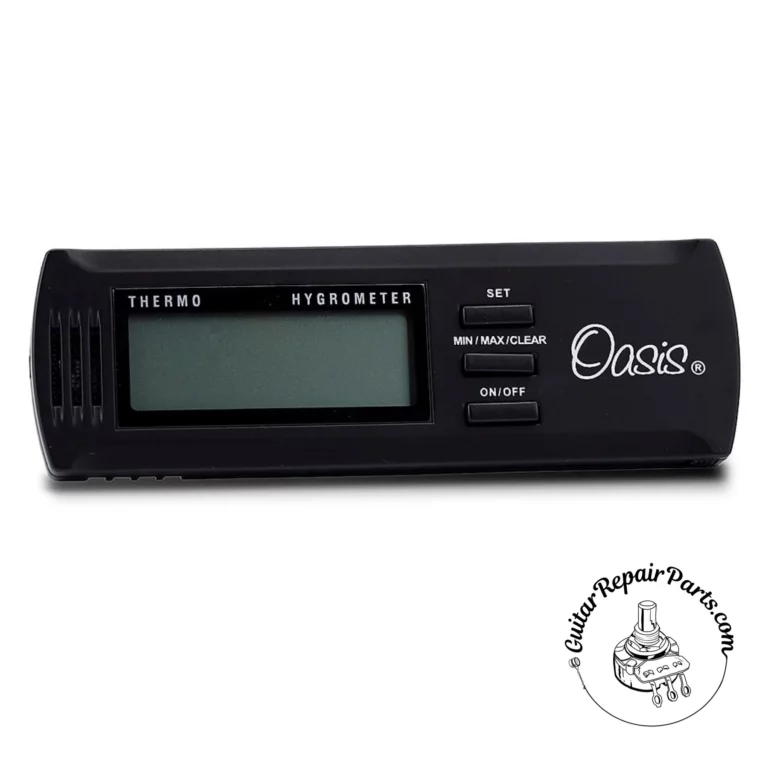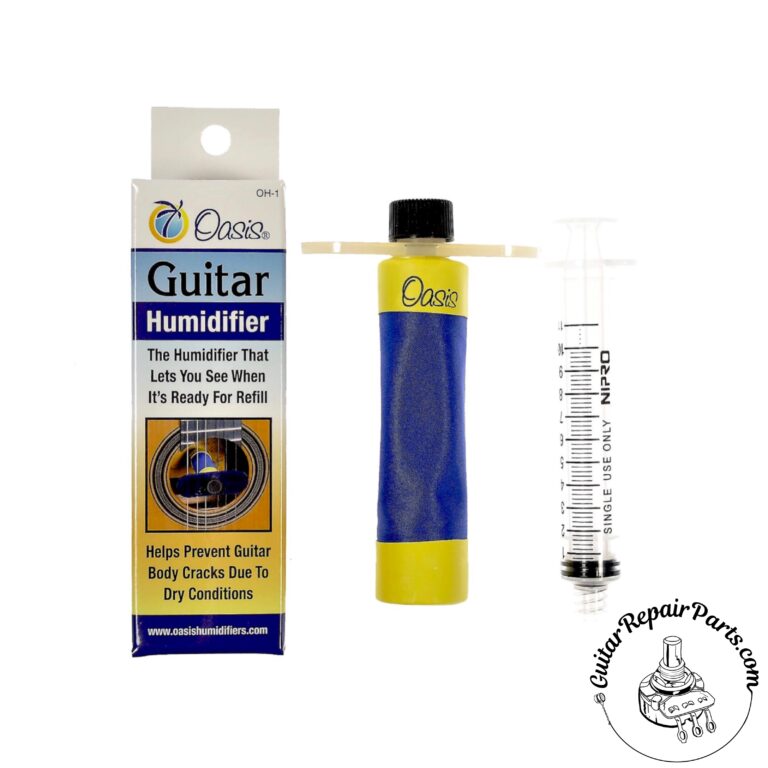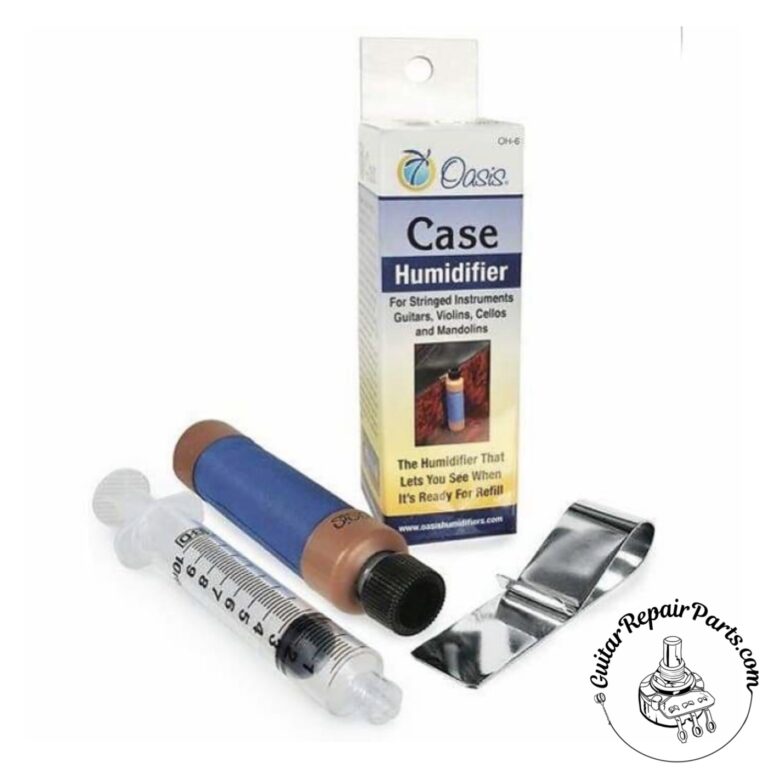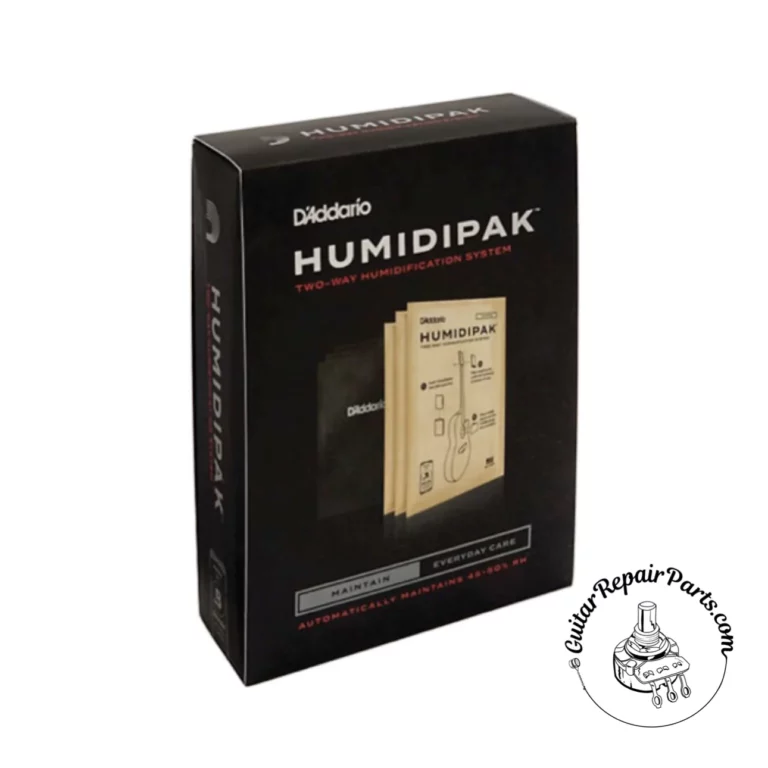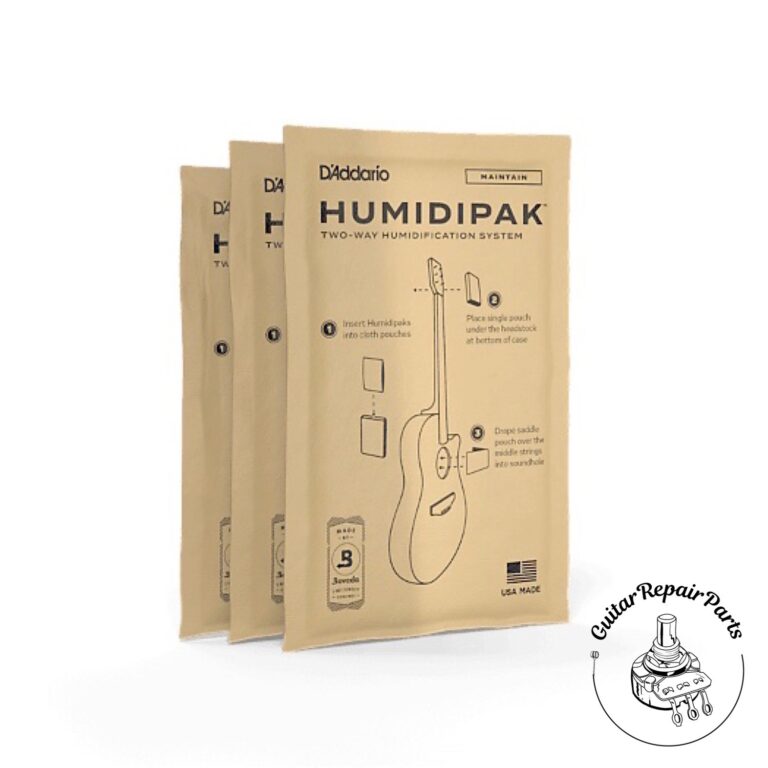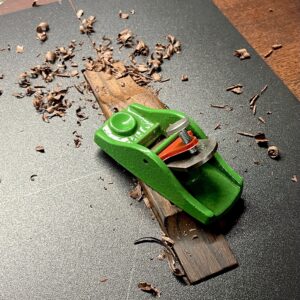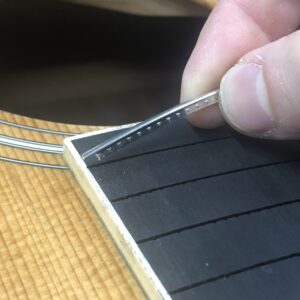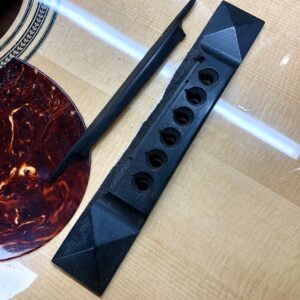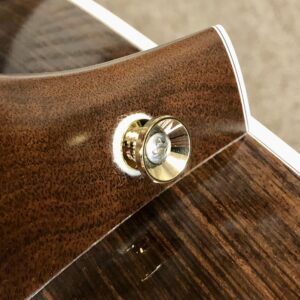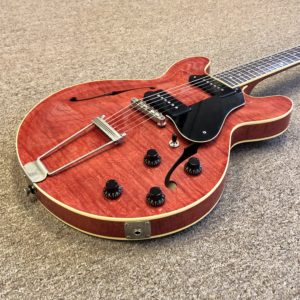Guitar Humidification
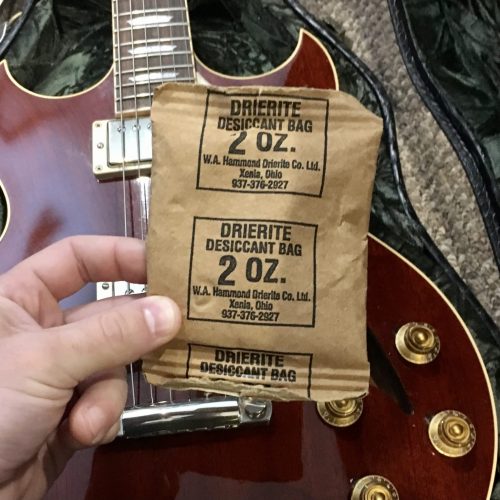
Wooden musical instruments are sensitive to their environment.
Changes in humidity can have a profound effect on your guitars!
Why Does Humidity Effect Guitars?
It’s easy to forget that wooden musical instruments are made of materials that were once part of the trunks of living trees. In their past life, their function was to transport water from the tree’s roots to its leaves. Towards this end, wood is what’s called “hygroscopic”. This means that the moisture content will change depending on the relative humidity of the surrounding air. When humidity increases, the wood absorbs moisture from the air causing the wood to expand. If the humidity decreases, it releases its water into the air and the wood shrinks. Though a fascinating marvel of the natural world, this property does present a complication for owners of musical instruments.
Tremendous effort has been taken to bend and sculpt wooden guitars and basses into exacting shapes; For ease of play, they are then adjusted within tight tolerances. As such, the expanding and shrinking that humidity change causes is sure to impact your guitars setup. If not well maintained, poor humidity control may eventually lead to major structural changes, requiring more involved repairs, including: fret sprout, fretwork, cracks, bridge lift, neck resets, or worse.
While all guitars and basses are subject to damage as a result of humidity changes, acoustic guitars are especially vulnerable. Due to their fragile design, they require a stable moisture content in order to remain healthy. Instruments are the most stable when maintained at between 40-50% relative humidity (RH). In many climates, this will take a bit of effort to achieve.
Improper care can lead to:
- Diminished playability
- Costly Repairs
- Diminished resale value
Common Signs of Humidity Issues:
- Unexplained Action Changes
- Sharp Fret Ends
- Loose fret work
- Corroded Hardware
- Warped Neck
- Sunken Soundboards
- Wood Cracks
- Seam Seperations
- Loose Binding
- Lifted Acoustic Bridges
- Rippled / Wavy Finish
- Loose / Cracked Braces
- Oxidized Electronic Connections
These are all largely preventable issues that you and your guitars need not experience.
When To Humidify A Guitar?
Here in the northeast, winter can be an especially dangerous season for your prized instruments. The colder months always keep our shop extra busy with dry guitars. Most of these visits could be avoided if players would educate themselves on the effects of humidity (water vapor), or lack there of, on their instrument.
The primary danger of winter weather comes not from the cold directly, but from the low humidity that comes with it. Cold air holds less moisture than warm air. To make matters worse, the heating systems we use to keep our houses warm remove humidity as a byproduct. This lack of humidity is the same reason we get dry skin and chapped lips; Dry air has a similarly negative effect on the wood used to craft musical instruments. In a heated household, it is not uncommon for the relative humidity to drop below 20%. This dryness can utterly destroy wooden instruments, rendering them unplayable.
When To Dehumidify A Guitar?
On Long Island we have large seasonal shifts; The colder months bring dry air and the warmer months are often quite humid. Too much humidity can bring its own share of problems as our wooden instruments absorb water vapor, causing them to swell.
Those with consistently air conditioned homes have a leg up in counteracting humidity, due to the fact that air conditioning units pull moisture out of the air as part of the cooling process. However, if you are without central A/C, or if the guitar is kept in a particularly damp environment such as a basement, too much humidity can still be a concern. Humidity readings that are consistently at or above 60% are cause for concern.
Humidity Protection Best Practices
- Use a hygrometer to accurately measure humidity levels
- Use a purpose built humidification device to add moisture when required
- Always store your instrument in a hardshell case
- Instruments ride in the car's cabin - NEVER IN THE TRUNK
- Bring your instrument in for an evaluation at the first sign of trouble
Tools For Humidity Maintenance
The expense and inconvenience of repairing damage caused by humidity, or in replacing a guitar that has been destroyed by it, is far greater than is required to maintain it. Below are some of our favorite solutions to help to keep your guitars playing great for years to come. Most are designed to work in conjunction with your instrument’s case.
Temperature and Humidity Gauges
You can’t fix a problem if you don’t know its there. Here are some of our favorite tools for getting an accurate humidity reading.
Oasis OH-2+ Digital Thermometer / Hygrometer
The Oasis Digital Hygrometer accurately measures relative humidity and can help you decide when to use your Oasis Guitar Humidifier. Because relative humidity varies greatly, even inside your home, we recommend that you keep your hygrometer close to your guitar, or any other stringed musical instrument made of wood.
With the convenient case clip, it is now possible to measure the relative humidity inside your guitar case so you see when it’s necessary to humidify the instrument. The clip attaches to the back of the OH-2+ hygrometer and is mounted on the flap of the supply box inside your guitar case.
D'Addario Humiditrak - Bluetooth Humidity Sensor
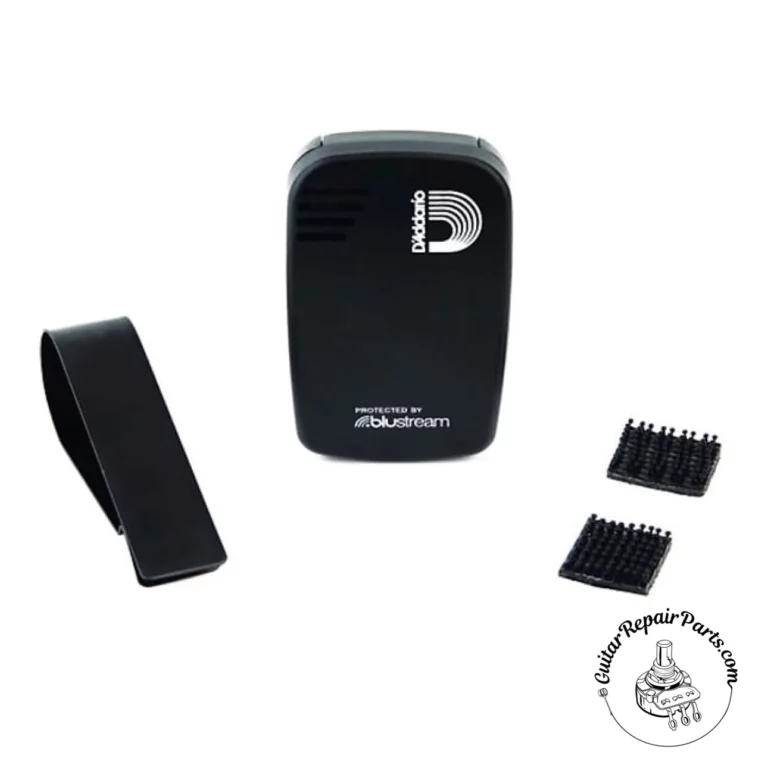
Humiditrak uses a patent-pending Bluetooth sensor to provide a constant stream of temperature, humidity, and impact data to the free smart phone app to alert you of hazardous conditions.
When Humiditrak detects danger, push notifications are sent to your device allowing you to take corrective action before damage occurs. Cataloging and monitoring a collection of instruments is so easy and convenient, you’ll want one for every instrument you own!
Guitar Case Humidifiers
Our favorite products to add or maintain moisture inside the case. These are great for players with only a handful of guitars to maintain.
Oasis Guitar Humidifiers
The Oasis guitar humidifier is made from a special fabric that allows water vapor, but not water, to pass through it. As more humidity is needed, the Humigel crystals release it, creating a vacuum that shrinks the humidifier. This lets you easily see when it needs to be refilled.
OH-1 Acoustic Guitar Humidifier
Like all acoustic guitar humidifiers, this device is designed to hand inside the body of the instrument when it is not in use. Unlike other humidifiers, the Oasis uses Humigel, super-absorbent polymer crystals, which is less likely to leak inside your precious instrument.
The Oasis hangs down from your guitar strings, thanks to a polyurethane stabilizing bar. This ensures that the humidifier won’t touch the back or sides of the guitar, potentially causing damage.
OH-6 Guitar Case Humidifier
This style of Oasis humidifier attaches to the inside of your instrument case. It is perfect for use with instruments that don’t have a sound hole. To accomplish this, two powerful neodymium magnets are inserted in the seam of the humidifier. The magnets attach to either a steel clip or a stainless steel strip with adhesive backing (both are provided with the humidifier).
The steel clip fits over the side of your case, providing a flat vertical surface to which the magnets can adhere. The neodymium magnets are strong enough to keep the humidifier attached to the clip or strip, but still allow the user to remove the humidifier with ease.
D'Addario Humidipak
Humidipak is the only maintenance free, two-way humidity control system for guitar. It automatically maintains the optimal 45- 50% relative humidity level within your instrument case. Unlike refillable humidifiers, this system provides true “two- way” purified humidity control by adding and removing moisture on demand. No more manual adjustments based on seasonal changes, geographic locations, temperature, or other factors.
Humidipak comes with 3 packets and a soft mesh pouch that will not harm your instrument’s finish. These packets last between 2 and 6 months and should always be kept in a sealed environment like a hard-shell case. Once the packets become firm, discard and replace using the 3 refills that come in the Humidipak Replacement Pack.
Guitar Case De-humidifiers
Protect Guitars that must be stored in high humidity environments.
EVERBAMBOO Guitar Dehumidifier Set
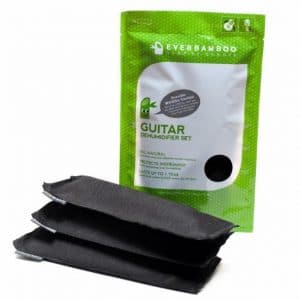
If you live where the humidity is very high all year round, or spikes during the summer months, this is a simple and effective way to combat the negative effects of high humidity. Ever Bamboo products have been used and tested to effectively aid in the process of keeping your solid wood instrument at the proper acceptable humidity range.
It offers both protection from becoming over-humidified, as well as aiding
in de-humidifying an instrument that has already seen the effects of prolonged humidity variables.
Frequently Asked Humidity Questions
For the collector with many guitars, or those that choose to display guitars on hooks and stands, individual humidifiers can become a bit impractical. Under these circumstances we recommend a whole room humidifier such as those available at stores like Target or Walmart.
These devices are plugged into the wall and can be used to humidify the air of the room your instruments are stored in, rather than isolating the instruments from it inside of a case. To use one, you simply set the dial on the humidifier to the appropriate level, place an external sensor in the room to be certain that you are getting the proper moisture level, and refill the reservoir as needed.
There are several different types and sizes of humidifiers available. The one you choose will depend on your budget, the size of room to be humidified, and if you would prefer a filtered or unfiltered device. In shop we currently use an evaporative unit that is sold by “Aircare Products”. As for required maintenance: During the season, we refill the reservoir once every day or two. Once or twice a season the unit requires cleaning and filter replacement. Its a small price to pay for the benefits it produces.
It is absolutely possible to over humidify a guitar. We recommend the use of a humidifier designed for instruments in conjunction with a humidity gauge to take the guess work out of humidity maintenance.
After learning about the humidity issues effecting their instrument, many a frustrated client has professed that “the guitar must be defective.” They logically reason that since the guitar in question is stored in the same location as others that are not showing the same symptoms, something must surely be defective with the instrument.
Though instruments may not be showing identical symptoms, in all likelihood they are in fact showing several of the symptoms of dryness listed above. The signs often go unnoticed until one has learned to identify them.
It’s important to note that guitars are not homogeneous. Even two models made right next to each other in the same factory will not be identical. Much like people, no two pieces of wood are the same.
Also, different models may have important variations in design and construction; Surprisingly, cheaply made acoustics with Laminate tops are more resistant to humidity damage than finer ones made with solid wood. Thin satin finishes offer less protection than thickly coated polyester. Hollow bodied instruments don’t react the same way solid bodies do. etc. etc. etc.
Here in shop, we routinely encounter dry guitars during the winter months. Before any setup or repair work can be done, they must first be returned to a proper humidity level.
To re-humidify a dry guitar, we use some of the same tools that have been recommended above for humidity maintenance. In our shop we use Oasis humidifiers combined with their OH-2 hygrometer to monitor the instruments progress daily.
The length of time required varies but typically requires a minimum of 5-7 days, up to several weeks, to return a dry instrument to ideal conditions; It is important not to move too quickly due to the risk of causing further damaging the instrument.

Erik Salomon - Calico Guitarworks Owner / Head Technician
Tech Talk articles are part of an ongoing effort to provide clear and detailed answers to common questions about guitar maintenance, modifications, and repairs.
While not intended as a step-by-step guide to servicing your own instrument, we hope that you will find value in the information provided.

Great Repairs Start With The Right Parts
Many of the parts mentioned in our blogs are available for purchase at:
GuitarRepairParts.com
Enter the code "TechTalk10" at checkout for 10% off your first order.
About Calico Guitarworks
Calico Guitarworks is the area’s premier destination for fretted musical instrument care and maintenance. Owned and managed by Erik Salomon, the shop is dedicated to providing quick, honest and reliable service. The staff at Calico Guitarworks has a combined 25+ years of professional guitar repair experience. Sharing the knowledge that we accumulate in this focused pursuit is at the core of what we do. Learn more About Calico Guitarworks, explore our Frequently Asked Questions, or Contact us with a specific request.

